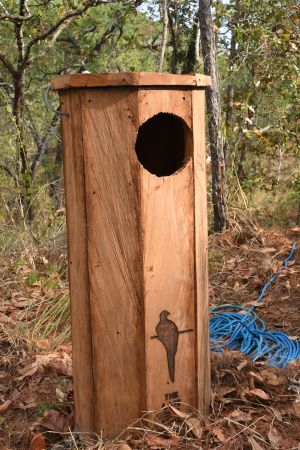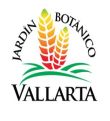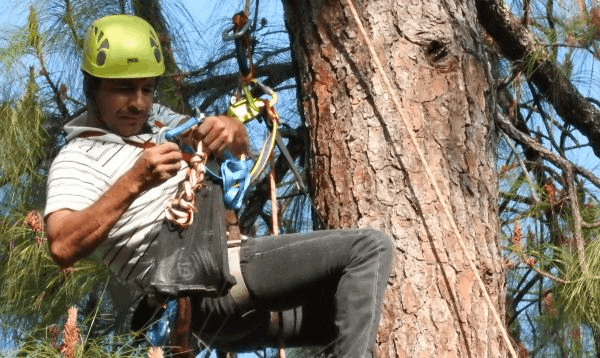Puerto Vallarta, Mexico - As part of an extended Earth Day Celebration at the Vallarta Botanical Garden, on April 23rd volunteers and guests took a field trip to the Rancho El Santuario (about a 20 minute drive from the Garden) to participate in the installation of a new nest box for the native Military Macaw, one of the largest and most colorful parrots in the Americas.
 |
The original impetus for this conservation project was a response to a senselessly cruel crime against nature. While visiting his ranch back in December of 2012, Francisco Espinoza Ibarra was horrified and saddened to see that someone had cut down the hollow old pine on his property that was home to an entire colony of Military Macaws.
The way the nest cavity was carved up by chain saw cuts was clear evidence that the motivation was to poach the hatchlings for sale on the black market as illegal pets. Not only did the former company of these majestic birds provide Francisco and his family with great joy, they were an excellent draw for tourists who would pay to see them, thereby providing an economic incentive for their continued care.
Something needed to be done to give them a second chance! As a response to this tragedy, volunteers from throughout Cabo Corrientes, Puerto Vallarta and beyond came together to install segments of the original trunk as "resurrected" nest sites. With the technical support of the Vallarta Botanical Garden and Vallarta Adventures, the project was quickly off the ground. Fast forwarding to the following nest season, miracle of miracles occurred and both nest boxes were occupied and resulted in yet another generation of young guacamayas (Spanish for "macaws").
Thanks in part to a donation of climbing equipment from Defenders of Wildlife, Francisco, along with his family and friends, have been installing more boxes and the guacamaya population at their ranch is expanding beyond their wildest dreams.
 |
McGrain was amazed by the work of Francisco and Jorge after visiting El Rancho Santuario in March at the invitation of the Vallarta Botanical Garden to participate in the Vallarta Bird Festival.
On the day of this most recent nest box installation, Vallarta Botanical Garden administrators pledged the sponsorship two more nest boxes, in honor of "Aves del Paraíso" a local not-for profit caring for rescued parrots. Another participant, Vallarta Botanical Garden member Susana Borneman, pledged a box as well, which will bring the total amount within Rancho el Santuario to an even dozen by the summer rainy season.
Aside from sponsoring a nest box (5,000 pesos or $250 USD each including carpentry, custom engraving, and installation) other sponsorship opportunities include donations to expand the preserve land of the Rancho El Santuario (currently at about 65 hectares), and installing solar powered cameras (to deter poachers, monitor the birds, and allow people from all over the world to visit virtually).
Those of you lucky enough to live in the Vallarta Region or have occasion to visit can experience the thrill of bird watching at the Rancho El Santuario for yourselves. A guided tour is only 200 pesos per person for groups of three or more, otherwise a minimum amount of 500 pesos is charged for either individuals or pairs. Tours may be booked by calling (322) 223-6234 or emailing novoapv(at)hotmail.com. Nature tours are even more rewarding when you know that you're contributing to great local conservation!
Claudia Méndez, Aves del Paraíso, contributed to this article. Contact her at conservaciondeespecieseducamb(at)gmail.com.

Visit the internationally famous Vallarta Botanical Garden located just 30 minutes south of Old Town at Km. 24 on Highway 200 and easily accessible by public transportation and taxi. This 60 acre wildlife preserve and botanical garden have something fun for everyone. Over 200 species of birds have been observed on the Garden's grounds. Don't forget to bring your swimsuit for a refreshing dip in the jungle river. See plantings of vanilla, chocolate, and hundreds of other botanical delights! Authentic Mexican Cuisine is served in the Hacienda de Oro Restaurant from 10 am to 5 pm. The Garden is open daily from 9 am to 6 pm (closed Mondays from April 1 to December 1). The Puerto Vallarta Butterfly Festival August 15 through October 30. Garden admission is just $150 pesos. For more information, call (322) 223-6182 or visit vbgardens.org.
Click HERE to learn more about Vallarta Botanical Gardens.



